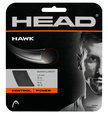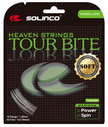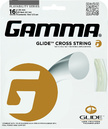Don't miss any stories → Follow Tennis View
FollowPolyester String
The pros use it. Should you?
Tune in to any men or women's professional tennis match, and the advancements of the modern game emerge immediately. Players swing faster and inject more energy into their shots. As a result, they generate unprecedented amounts of power and topspin.
Bob Patterson, Special Projects manager for the United States Racquet Stringers Association and owner of the racquet stringing company, Racquetmaxx, attributes this trend to the proliferation of polyester and co-polyester strings.
“Polyester and co-polyester are kind of the hot item and have been for the last four or five years,” Patterson said. Today’s professionals have shifted towards polyester and co-polyester strings because of the stiffness and durability that allows them to inject plenty of topspin.
Patterson cites Rafael Nadal as the prime example of what polyester strings can accomplish. Nadal uses polyester string on both the crosses and mains of the racquet to facilitate his topspin-oriented strokes.
DURABILITY
Polyester string is the answer for baseline players who generate their own power and tend to break a lot of strings. Today's professionals are bigger, stronger and swing faster, so polyester’s durability and lack of movement in the string bed are very attractive features. In fact, all of the top 10 men and women currently use polyester or a co-polyester mix.
An area of confusion with polyester is how long it lasts. Experts say that recreational players should not confuse polyester's durability with resilience. While polyester does not break easily, it does lose resilience or responsiveness much faster than other material does. This loss of resiliency is why many pros request racquets be strung during matches.
Recreational players, though, must remember to replace string when it loses its feel. A lot of players assume that their strings only need to be replaced when (and if) it breaks. To keep your racquet performing its best regular maintenance is necessary and that means fresh string.
THE ELBOW
Contrary to popular belief, Patterson says that it is not the stiffness of the string that causes arm injuries. Instead, it is that recreational players tend to play with dead string – string that is past its prime and unresponsive. Old string not only reduces performance, but also is hard on the arm. And regardless of whether the strings are polyester, natural gut or another material, it is important to replace string regularly.
If a softer string is preferable but the spin effect of polyester is desirable, using a softer synthetic or natural gut in the mains or crosses may be a good compromise. Due to customer demand, Patterson says that manufacturers are currently working to develop polyester string that is softer, more elastic and more forgiving on the arm.
TENSION
At the same time that more players are turning to polyester, they are opting to reduce their string tension. “When I first started working on the pro tour back in the early 90s, it wasn’t uncommon for people to string in the high 70s and even as high as 80 pounds or more,” Patterson said. “Now you have guys stringing as low as 35 pounds.”
But why are the hardest-hitting professionals opting to reduce their string tension, considering that lower tension leads to less control and more power? The answer lies in the stiffness of polyester strings.
Gut and synthetic string are softer and have a lot of stretch, which allows the ball to embed into the string. To compensate, players lower their tension, which gives the ball more pop. “I think people have finally caught on that if you’re using a polyester or co-polyester string, you have to lower the tension to get the best benefit from it,” Patterson said.
Choosing string can make all the difference in the comfort and success of your stroke, but what works for the pros will not work for everyone.
“The general public doesn’t pay enough attention to the string,” Patterson observes, adding that “it’s not rocket science, but it is racquet science.”
There's a learning curve to understanding string, so recreational players are advised to take their time in the decision-making process. When determining if polyester string is the right fit, don't be hesitant to demo a variety of strings to find what works best. And to help cut through the confusion, find a good stringer. –Staff
Babolat RPM Team
Players wanting the spin and control of the RPM Blast– but with a softer, more flexible response turn to the Babolat RPM Team. A low-density co-polyester monofilament that's available in 16 and 17 gauges, and color black. babolat.com
Head Hawk Tour
Players seeking great bite and an abundance of spin should reap the rewards of using the Head Hawk Tour string. A Co-polymer Monofilament that's available in 16, 17 and 18 gauges with choices in colors grey or white. head.com
Dunlop Explosive
Explosive poly provides excellent “snap back” effect for maximum string movement and bite, adding weight to every shot. A monofilament Polyester that's available in 16, 17 and 18 gauges with choices in colors silver or yellow. dunlop.com
Solinco Tour Bite Soft 
This softer, more forgiving version of Solinco's Tour Bite string blends power, control, and spin potential with improved comfort. This soft co-polyester monofilament is available in 16, 16L and 17 gauges in color silver. holabirdsports.com
Gamma Glide Cross 
Every main string will play better, provide more spin, power and comfort thanks to Glide Cross' “lubricity” (defined as the inverse of friction). Glide is available as a half set, a mini reel, and as a hybrid set with either GAMMA Moto polyester or GAMMA Live Wire XP. gammasports.com
This article is from the Sept/Oct 2014 - US Open issue |
|

|
SOLD OUT Subscribe now and you'll never miss an issue!
|










